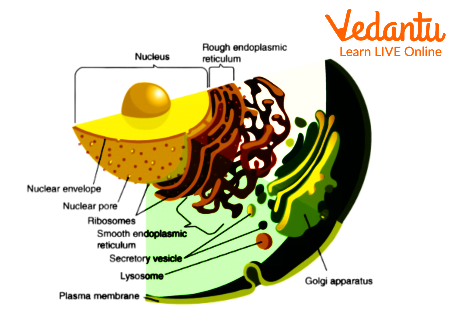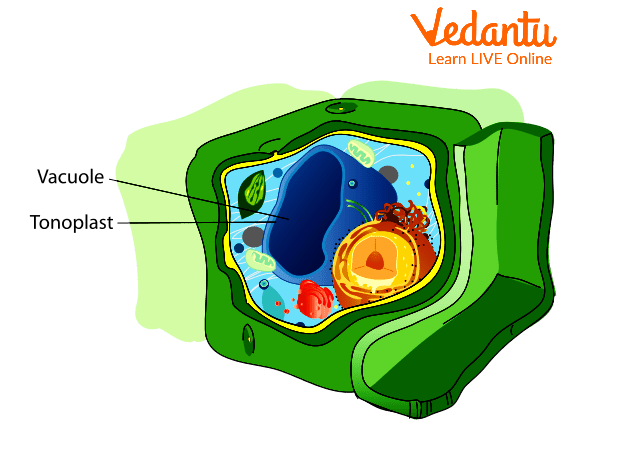Endomembrane System : An Introduction
The endomembrane system divides the cell into various organelles or compartments, including the nucleus, the endoplasmic reticulum (ER), the Golgi apparatus, and lysosomes. The ER gives rise to the endomembrane system, which then travels to the Golgi apparatus, where lysosomes develop. The ER is a continuous system of tubules and flattened membrane sacs that is designed specifically for lipid production and protein processing. For the compartmental arrangement of the cell to operate autonomously and correctly, the endomembrane system is critical. Consider yourself a pancreatic cell. It's your responsibility to release digestive enzymes, which enter the small intestine and aid in the breakdown of food's components.
Endomembrane System
Although the structure and function of each membranous organelle vary, they are all distinct from one another. Since their functions are coordinated, many of them are regarded as being part of an endomembrane system. Endoplasmic reticulum (ER), Golgi complex, lysosomes, and vacuoles are components of the endomembrane system. The mitochondria, chloroplast, and peroxisomes are not regarded as components of the endomembrane system because their functions do not overlap with those of the components mentioned above.
Endoplasmic Reticulum
A membranous structure called the endoplasmic reticulum is an important component of the endomembrane system of a eukaryotic cell that divides the intracellular space into luminal and additional luminal (cytoplasm) compartments.
Endoplasmic Reticulum Structure

Endoplasmic Reticulum (ER)
Endoplasmic reticulum structure comes in two varieties: smooth endoplasmic reticulum and rough endoplasmic reticulum.
Rough Endoplasmic Reticulum Structure
Ribosomes are affixed to the cytoplasmic side of the membrane in rough ER. A collection of flattened sacs make up the rough ER. The lumen is the name of the area inside the ER.
The name comes from the fact that it is an attached flattened sac with a few ribosomes on its exterior.
It produces and releases chemicals, various compounds, and proteins in the liver and glands.
In cells that synthesize protein, rough ER is noticeable.
Functions of Rough Endoplasmic Reticulum
The majority of the rough ER components are involved in protein synthesis.
Additionally, the rough endoplasmic reticulum plays a significant role in protein folding.
Makes quality control in addition.
After protein synthesis and protein folding, protein organizing is the third most important ability.
Structure of the Smooth Endoplasmic Reticulum
On the other hand, ribosomes are absent from the smooth endoplasmic reticulum.
The tubular structure of the smooth endoplasmic reticulum is present.
It takes part in the production of phospholipids, which are the primary lipids in cell membranes and are necessary for digestion.
The Golgi apparatus, in particular, receives the outcomes of the rough ER's work from the smooth ER.
Function of the Smooth Endoplasmic Reticulum
The creation of vital lipids like cholesterol and phospholipids depends on smooth ER.
The release of steroid hormones is another function of smooth ER.
It is also in charge of glucose metabolism.
Calcium ions are stored and released by the smooth ER. Both the neurological system and the muscular systems depend on them.
Golgi Complex

Golgi Complex
It is one of the endomembrane system's single membrane-bound organelles. The Golgi complex is mostly located in the cytoplasm of the cisternae, or membrane sacs, of eukaryotic cells. A Golgi stack has four to eight cisternae. The cis face and the trans face are the two faces of each Golgi stack. The entry face and exit face are additional names for both faces. Protein packaging and secretion are two of the Golgi apparatus' primary roles.
Lysosomes
It is an organelle with a single membrane that houses hydrolytic catalysts for the disintegration of various biomolecules. Nucleases, proteases, lipases, glycosidases, phosphatases, phospholipases, and sulfatases are among the hydrolytic proteins included in this group. The molecule needs an acidic environment inside the lysosomes with a pH of roughly 5.0 for optimal action. There stays present a proton siphon inside the lysosomal layer. This proton siphon ships the proton from inside the film involving ATP as a wellspring of energy. Lysosomes are responsible for absorbing both intracellular and external materials because they can distinguish between infection particles or microorganisms during macrophage phagocytosis.
Vacuole

Vacuole
A vacuole is a membrane-bound structure that can be found in a cell's cytoplasmic membrane. Tonoplast is the name for the membrane that encases the vacuole. The vacuole's constituents, referred to as the cell sap, are distinct from the cytoplasm around it. Phospholipids are used to create layers. Proteins are injected into the layers to aid in the movement of molecules across the membrane. These proteins come in different combinations that help the vacuoles hold different matter.
Key Features
A membranous element of the eukaryotic cell is the endomembrane system.
A system of suspended membranous organelles is present in the cell's cytoplasm. Despite having various forms and activities, the organelles are referred to as a system since they are necessary for the proper operation of the cell.
The cell membrane, vacuoles, the nuclear membrane, lysosomes, the Golgi complex, vesicles, and the endoplasmic reticulum are all organelles that collaborate (ER).


FAQs on Endomembrane System
1. What is the endomembrane system as defined in the Class 11 NCERT syllabus?
The endomembrane system is a network of membrane-bound organelles found within a eukaryotic cell that function in a coordinated manner. According to the CBSE syllabus for Class 11, its primary roles involve the synthesis of proteins and lipids, their modification, packaging, and transport to their final destinations, either inside or outside the cell.
2. What are the main organelles that make up the endomembrane system?
The endomembrane system is composed of four key organelles whose functions are coordinated. These are:
- The Endoplasmic Reticulum (ER), including both rough and smooth types.
- The Golgi apparatus (or Golgi complex).
- Lysosomes.
- Vacuoles.
While not an organelle, the nuclear envelope is also considered functionally connected as its outer membrane is continuous with the rough ER.
3. What is the major functional difference between Rough Endoplasmic Reticulum (RER) and Smooth Endoplasmic Reticulum (SER)?
The main difference lies in their structure and function. The Rough Endoplasmic Reticulum (RER) is studded with ribosomes on its surface and is primarily responsible for synthesising and modifying proteins that are destined for secretion or insertion into membranes. In contrast, the Smooth Endoplasmic Reticulum (SER) lacks ribosomes and is the main site for lipid synthesis, steroid hormone production, and detoxification of drugs and poisons.
4. What is the correct pathway for a protein synthesised for export from the cell?
The pathway, often called the secretory pathway, follows a precise order:
- A protein is first synthesised on ribosomes attached to the RER.
- It enters the RER lumen for initial folding and modification.
- It is then transported in a small vesicle to the Golgi apparatus.
- In the Golgi, it undergoes further processing, sorting, and packaging.
- Finally, it is enclosed in a secretory vesicle that moves to the plasma membrane, fuses with it, and releases the protein outside the cell (exocytosis).
5. Why is the Golgi apparatus often referred to as the 'post office' or 'packaging centre' of the cell?
This analogy is used because the Golgi apparatus functions as a central processing and dispatching station. It receives proteins and lipids (the 'packages') from the Endoplasmic Reticulum, modifies and sorts them, and then 'addresses' or tags them for delivery. It then packages these molecules into vesicles to be sent to their correct final destinations, such as lysosomes, the plasma membrane, or for secretion out of the cell.
6. How do plant cells manage cellular waste and defence without having prominent lysosomes like animal cells?
While some plant cells may have small lysosome-like bodies, their primary hydrolytic compartment is the large central vacuole. The vacuole contains digestive enzymes and can break down waste products and worn-out cell components, effectively taking over the role of lysosomes. For defence, plant cells rely on their cell wall as a physical barrier and an internal immune system involving defensive proteins.
7. If mitochondria and chloroplasts have membranes, why are they not considered part of the endomembrane system?
Mitochondria and chloroplasts are excluded because their membrane synthesis and functions are not integrated with the ER-Golgi pathway. They are considered semi-autonomous organelles because they contain their own DNA and ribosomes and synthesise many of their own proteins. Their primary roles are in energy conversion (cellular respiration and photosynthesis, respectively) and are separate from the protein/lipid transport system.
8. What would happen to a cell if its Golgi apparatus was non-functional?
If the Golgi apparatus stopped functioning, the cell's entire system for processing and transporting proteins and lipids would collapse. Proteins synthesised in the ER would not be sorted, modified, or dispatched to their correct locations. This would halt secretions, prevent the replenishment of membrane proteins, and stop the formation of new lysosomes, leading to a buildup of waste and ultimately, cell death.
9. Why do mature mammalian red blood cells (RBCs) lack an endomembrane system?
The absence of an endomembrane system, nucleus, and mitochondria in mature RBCs is a critical adaptation for their function. This lack of organelles maximises the intracellular volume available for haemoglobin, the protein that carries oxygen. It also gives the cell a biconcave shape and high flexibility, allowing it to deform and squeeze through the narrowest capillaries to deliver oxygen throughout the body.










